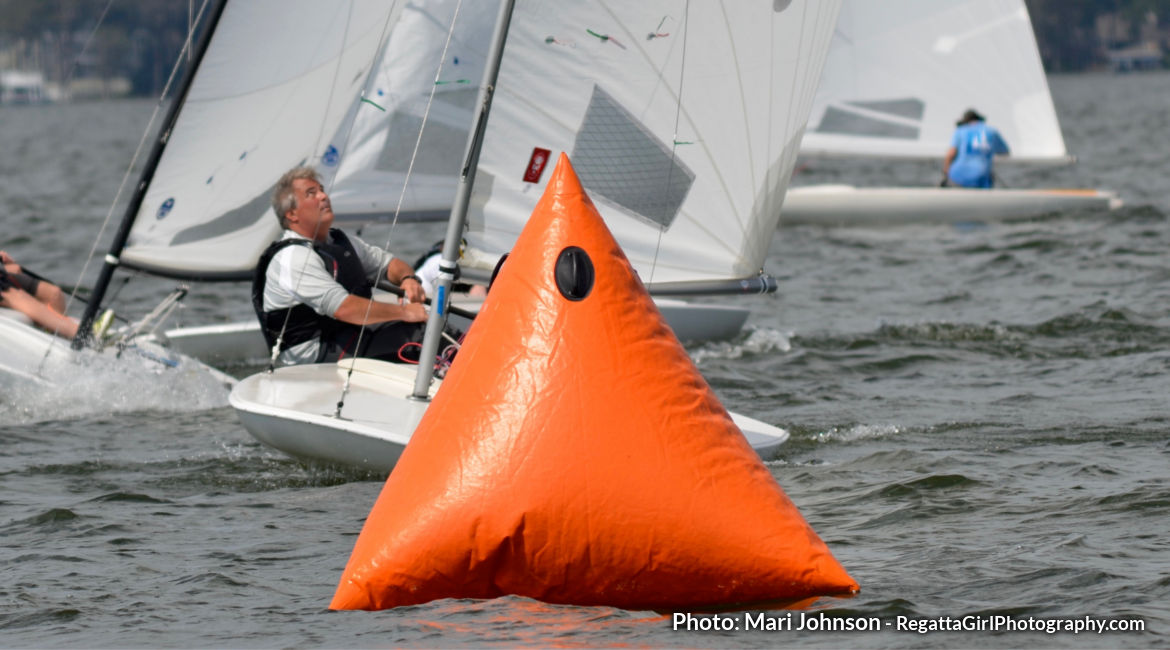You can gain or lose boats quickly while approaching, rounding, and exiting the windward mark. There are plenty of things to worry about, so we’ve compiled a windward mark preparation checklist to help you think ahead and consider everything.
We’ve pulled together tips from lots of sources, including Speed and Smarts, Championship Tactics, Advanced Racing Tactics, Performance Racing Tactics, The Final Beat, and the South Cerney (UK) Sailing Club.
Last Third of the Beat
Being ahead of the game is critical, and the last third of the beat is not too early to start windward mark preparation.
- Make sure you can see the windward mark and estimate the laylines
- Review your strategy for finishing the beat based on:
- Fleet and competitor position
- Favored side, due to more breeze or expected final shift
- Clear air
- Avoiding the laylines early
- Make sure you can quickly locate the leeward mark after rounding – either visually or with compass bearing
- Consider a preliminary plan for the downwind leg based on:
- Favored side of the beat (which side paid off overall or most recently)
- Position in race
Approaching the Starboard Layline
You can make big gains by choosing correctly here. Plan your approach to the starboard layline, maximizing the factors below:
- Stay in good breeze on the lifted tack for as long as practical
- Maintain clear air
- Avoid getting in dead air between laylines with crowds on laylines and offset leg
- Avoid getting on the starboard layline with crowds ahead of you
- Use tactics
- Cover boats behind
- Pin boats even or slightly ahead
- Split from boats ahead if it makes sense
Final Tack
Make your final tack to the layline, considering:
- Risk of fouling if tacking in the three boat-length zone
- Distance remaining and ability to accurately judge layline
- Overstand if necessary to maintain clear air
- Tack earlier in good breeze or with expected favorable shift
- Time to prepare for rounding
On the Layline
Ideally, once you’re on the layline, preserve your gains while getting ready to round and planning the next leg.
- Trim and steer carefully to maintain speed and pointing
- Bail out early if changes prevent fetching the mark
- Protect your lead
- Lee bow and pinch up on boats behind and to windward
- Sail down if boats behind and to leeward threaten to pass
- Sail down on boats threatening to tack ahead of you
- Refine plan for next leg based on:
- Headed gybe (opposite of current lifted tack)
- Favored side
- Best breeze to escape on
- Check the lay of the offset leg in case you need to sail past the windward mark to fetch it
- Get ready to round
- Free up sheets and be ready to ease
- Adjust sail controls for a reach
- Ensure you are moving fast
At the Mark
Once you’re at the mark and clear of other boats, rounding should be easy.
- Round close, leaving room only for boom, anchor line, and unexpected motion of boat or mark
- Round smoothly using body weight and sail trim to assist turn
- Flatten boat to windward
- Big ease on main, keep jib tight (unless over-heeled)
On the Offset Leg
Lots to do on this short leg, so don’t relax.
- Maintain speed
- Watch trim – no stalling or luffing
- Adjust board height
- Tweak sail controls
- Finalize plan for downwind leg
- Locate mark
- Determine whether you will bear off or gybe, based on:
- Boats ahead
- Favored side of run
- Long gybe
- Ability to maintain speed
- Location of next puff
- Bad air to leeward of offset leg and from boats behind
- Fewer maneuvers in light air
- Position to round offset
- Inside – this gives you the most flexibility to either gybe immediately or bear off
- OK to be outside if you’re going to bear off
- Set up for gybe or bear off
Rules at Marks: Rule 18, Part 1
Rules at Marks: Rule 18, Part 2
The Windward Mark: Strategy and Tactics – from South Cerney Sailing Club
Mark Roundings with Peter Vaiciurgis
Leeward Mark Preparation Checklist






Very important to know the rules when doing these roundings, especially in larger fleets. Mainly to protect yourself, not necessarily to get over on others.
Danny Z
I agree, Danny. There’s certainly enough experience out there to demonstrate the folly of taking unnecessary risks. It would be great if everyone knew the rules and observed them. Readers can check out our articles on the racing rules, with some very well-done animated scenarios.